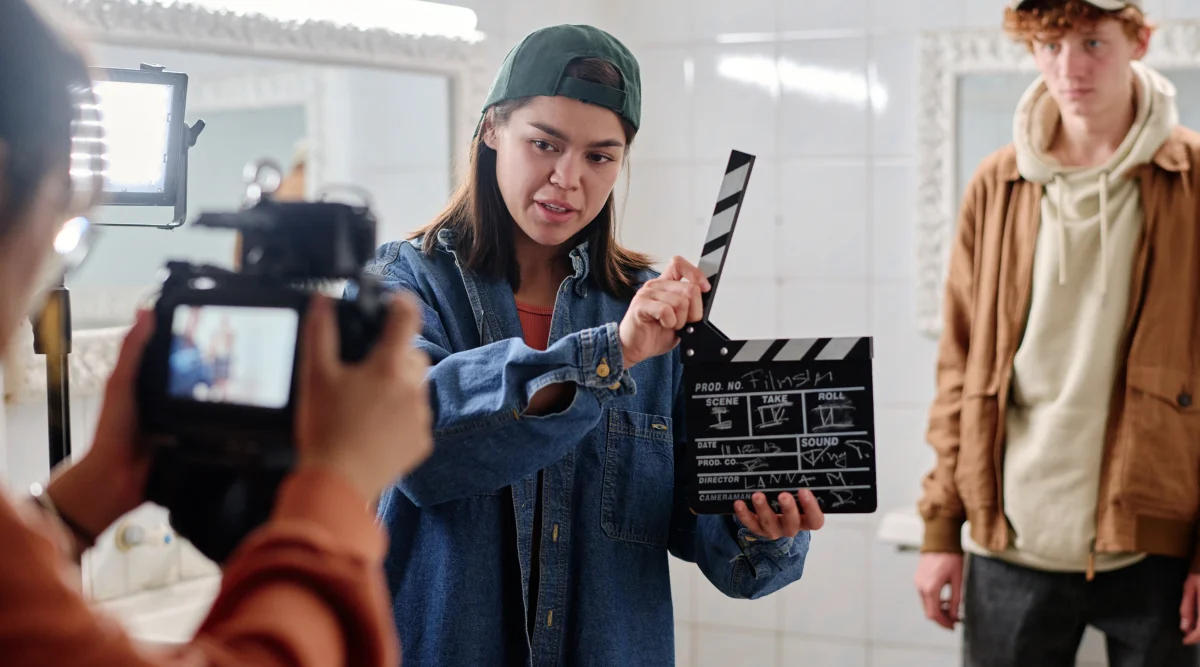According to intellectual property laws defined in the Copyright Act of 1976, you own the rights to your cinematic creation from the moment you call “cut” and save the footage to a disk or hard drive. You do not legally have to do anything else to lay basic legal claim to your creative work.
Many filmmakers, however, choose to go the extra mile and formally copyright their work with the United States Copyright Office. Why? Copyright registration adds an extra layer of protection—including the option to bring a lawsuit in the event of infringement.

Is copyright registration worth the extra effort? Let's take a look at some of the benefits and requirements.
Advantages of copyright registration
As the creator or co-creator of a short film or movie, you reserve the right to reproduce, distribute, or otherwise share your film publicly. But what happens if someone else attempts to share your work without permission? Or worse, take credit for it? Proper copyright registration will make it easier to legally protect your production.
The advantages of copyright registration include:
- Ability to bring a copyright infringement suit. If someone infringes on your rights as the creator of a work, a registered copyright will allow you to file an infringement suit in federal court.
- Evidence of validity of copyright. When you register your copyright, you establish evidence of a valid copyright, as long as registration was made before or within five years of the publication of your work.
- Eligibility for statutory damages. If you registered your copyright before an act of infringement, or within three months after the publication of your work, you are eligible for statutory damages, attorney fees, and costs.
- Importation protection. Registration establishes a record with U.S. Customs and Border Protection, giving you protection from the importation of infringing copies of your work.
- Creation of a public record. This lets the world know that you own your work and helps people find you if they want to license it.
How to copyright a short film or a movie
Here are the basic steps you need to take to copyright a movie or short film.
Step 1: Decide who will own the copyrights
Typically, movie producers will own the copyright to the film. If there are multiple producers, they will each share equal ownership of the work and be co-owners of the copyright unless there is a contractual agreement otherwise. Screenwriters, composers, and other similar contributors hold the copyright to their individual work.
Step 2: Prepare the necessary materials
Save and backup your video files and prepare a brief synopsis of the movie. You will also need to provide the date the film was first “fixed” in a copy.
Step 3: Create an account on the U.S. Copyright Office website
Head to the U.S. Copyright Office registration portal and log in to the Electronic Copyright Office (eCO) Registration System. You will create an online account that will allow you to register your work.
Step 4: Complete the online application
After you create your account, you will have the option to complete the standard application. Review the information on the first page of the application to confirm that your work is eligible. If it is eligible, you can proceed to select "Motion Picture" from the drop-down menu and complete the application by filling in the title, creation date, publication status, personal information, and other information to verify ownership.
Step 5: Pay the filing fee
When you've completed the form, you'll proceed to payment. As of this writing, the fee for a standard application is $65, but that is subject to change. You can verify the most recent copyright fee schedule on the official Copyright Office website.
Step 6: Upload a copy of the movie
After you've paid the fee, you'll be prompted to upload your film file. Be sure to review the accepted file types and sizes provided on the upload page. You may need to compress your video file or divide it into smaller files to meet the requirements. If you have the appropriate file, start the upload and wait for confirmation that it was successfully uploaded. If you need to send a physical copy of your work, you can print a shipping slip instead.
Step 7: Submit the application
You can complete your submission once you’ve uploaded the digital file or printed the shipping slip. The final submission page will show you all the information you entered previously. Make sure all the information is correct before you submit your application. Once your application is submitted, you will receive a confirmation receipt in your email. All you have to do now is wait for the copyright office to review it. If your claim is approved, you should receive your registration certificate within two months.
Mail-in copyright application
If you would rather mail in your application, you can print Form PA (For a Work of Performing Arts) and mail it to the Library of Congress (the address is listed on the form) along with payment, a copy of your work on a thumb drive or disk, and a written description of your work. Note that mail-in applications take longer to process, and the fee is $125.
Deposit requirements for registration
Whether you apply online or by mail, your application is not complete until you meet the deposit requirement. For published movies or short films, you will need to send in a separate description of your work that outlines its nature and general content, as well as one complete copy of the work. A work is considered “published” when one or more copies are distributed to the public.
If you have not yet published your movie or short film, you can send a separate description of the work, along with a copy of the work that contains all the visual and audio elements that will be covered by the copyright registration.
What is the effective date of copyright registration?
The effective date is a vital detail in copyright infringement cases. Some mistakenly think that it's the date they receive their registration certificate. But according to copyright laws, you do not have to wait for the copyright office to send you the certificate before your film receives formal copyright protection. The effective date of your registration is the date on which the Copyright Office receives all of the following parts of your application:
- Your completed application form
- Appropriate filing fee
- A deposit in acceptable form
If you're filing online, the effective date is the date you receive the email confirming your submission. If you send incomplete materials the first time, however, the effective date will be set when you send in the remaining components.
How much does it cost to copyright a film?
Copyright fees are set and adjusted to be fair and equitable in current market conditions, encouraging authors to register their works while still covering the Office's expenses. As of this writing, the fees for a film or movie copyright are as follows:
- Online registration for a single movie or short film with only one claimant: $45
- Online standard application (for multiple claimants): $65
- Mail-in registration: $125
- Registration of a claim in a group of unpublished works: $85
- Preregistration of certain unpublished works: $200
- Registration of a correction or amplification to a claim: $100 for electronic filing or $150 for paper filing
As much as we all hate fees, it's a small price to pay to give your cinematic masterpiece additional protection.
Additional ways to protect your film
While a copyright gives you legal recourse for infringement, there's a lot you can do to prevent infringement in the first place:
- Watermarks. Add a faint name or logo, known as a watermark, over your movie when sharing it with others to deter people from copying or distributing your film without permission. It's an easy way to identify you as the creator and signal to would-be copycats that you are serious about protecting your work.
- Metadata. You can also embed copyright information into the film's metadata. Metadata is not visible on your film but stays with your file wherever it is shared. Most film editing software will have an option to include this. You can also include it on the file itself after you save it.
- Copyright notices. For added protection, include a copyright notice ( © [Year] [Your Name] ) visibly in the film credits or accompanying materials.
- Distribution controls. Whenever you share your film, use a secure platform (Google Drive, Dropbox, etc.) that will prevent unauthorized copying. Set clear terms of use and licensing agreements with everyone you send a copy to, even if you just send it to a friend to get feedback.
Being proactive about infringement can save you the trouble and costs of litigation.
FAQs
How should I respond to the unauthorized use of my film?
There are a number of digital tools you can use to monitor your copyrighted works across the internet. If you discover someone using your work without permission and outside of the "fair use" doctrine, the first step can be a formal "cease and desist" letter that demands the infringer stop using your video(s). Ideally, they will either comply or ask to negotiate a settlement or license agreement without going to court. If they persist and continue to violate copyright laws, you can file a lawsuit.
How long does it take to copyright a movie?
The time it takes to copyright a movie depends on several factors. The first step is to fill out the appropriate forms either electronically or by mail and submit your deposit. If you do not submit all the parts of your deposit (payment + written description + complete copy of the movie), that will slow the process down.
If you file electronically, and there is no further correspondence, it typically takes a little over a month to receive your certificate. If you file by mail, it can take up to four months. Both of these processes can take longer (up to nine months in some cases) depending on how complex the claim is and how much extra communication is needed to complete the process.
Regardless how long the process takes, however, your copyright registration is considered effective from the day the copyright office receives your completed application and deposit.
Do I need a public performance license to use music in a movie or short film?
A public performance license allows copyrighted music to be played in public. If you are using another artist’s music in your film, you’ll likely need two separate licenses: a synchronization license and a master use license.
How long is a movie copyright valid?
Film copyrights for works published after 1978 last for the lifetime of the author plus 70 years. If a work is anonymous or published under a pseudonym, the copyright is good for 95 after its first publication or 120 years after its creation (whichever comes first).
Belle Wong, J.D. contributed to this article.


